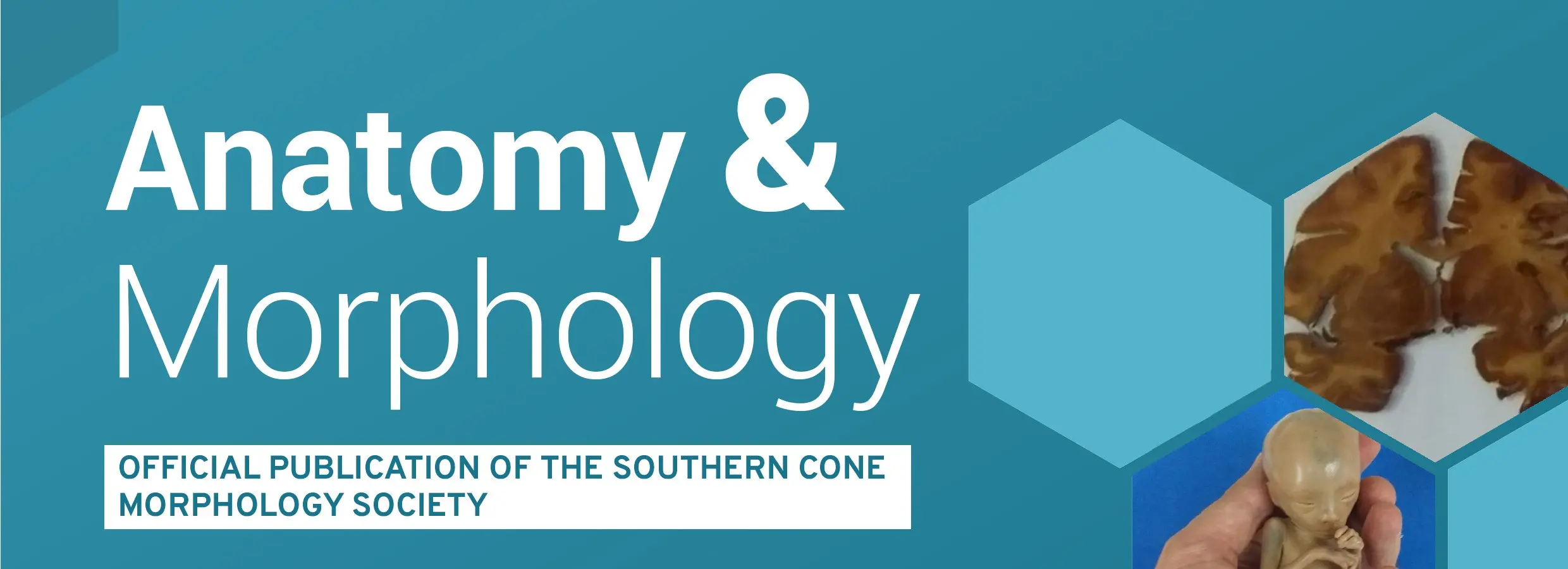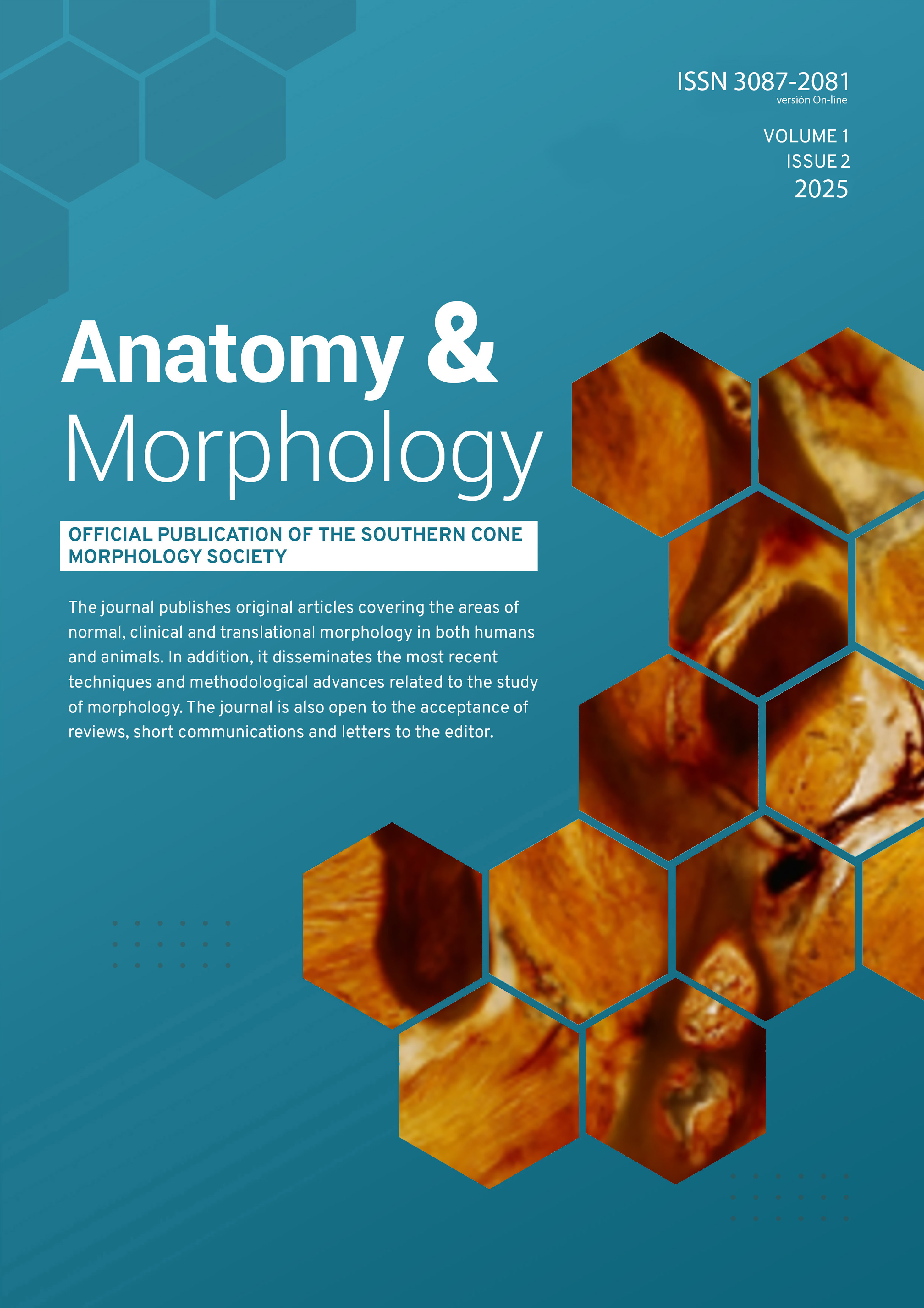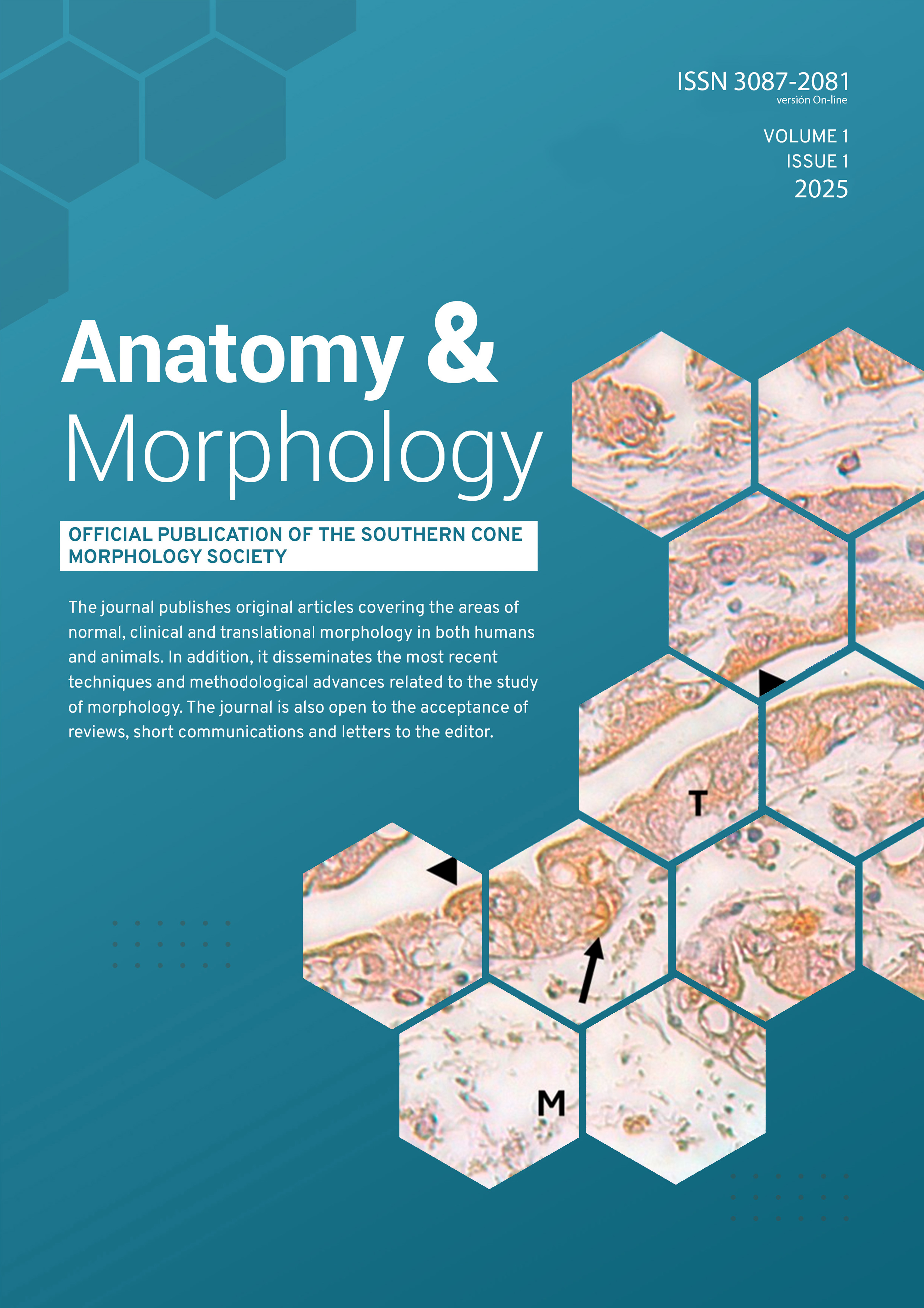Welcome to Anatomy & Morphology
Anatomy & Morphology (Online ISSN 3087-2081) is a quarterly publication that aims to disseminate original research and research methods related to anatomy and morphology in all its aspects of Gross Anatomy, Clinical Anatomy, Endoscopic Anatomy, Laparoscopic Anatomy, Histology, Embryology, Normal and Experimental Morphology and Developmental Biology. In addition to research articles, the journal also accepts reviews, short communications, and letters to the editor. All articles are subjected to rigorous evaluation by independent expert reviewers. Anatomy & Morphology is a peer-reviewed and open access journal.
Latest published issues
Most visited post
1. Introducing “Anatomy & Morphology”
It is my pleasure to introduce Anatomy & Morphology, a new peer-reviewed journal dedicated to providing a focused platform for research, discussion, and innovation in the structural sciences. As the Editor-in-Chief, I would like to share the vision behind this endeavor and highlight why a journal devoted exclusively to Anatomy and Morphology is both timely and essential.
2. On The Triune Brain: A Modern Myth In Neuroscience
The purpose of this study was to analyze the validity of the proposed triune brain hypothesis, which appears in various neuroanatomical and neuroscientific literature. To this end, several modern texts published between 2015 and 2025 were randomly and conveniently reviewed to determine whether terms related to this theory were still in use. All texts evaluated revealed the continued use of terminology that supports the outdated popular theory of the triune brain, thus categorizing it as a neuromyth. This is because humans do not possess brain parts from other species, and mammalian species do not increase in complexity linearly, but rather evolve from common ancestors.
3. Immunohistochemical Identification of Calcium Transporters in the Placenta of Alpacas (Vicugna pacos)
The placenta plays an essential role in calcium transport and regulation during gestation; however, few studies have investigated the identification of placental transporters in animals. The present study aimed to identify calcium transporters in the placentas of postpartum alpacas. A total of 12 placentas were collected from adult huacaya alpacas. The mate- rial was fixed with a 10% formaldehyde solution and reduced in paraffin blocks. The material was fixed with a 10% formaldehyde solution and reduced in paraffin blocks. Sections measuring 5 μm were subjected to hematoxylin- eosin staining and immunohistochemical reactions to detect calbindin D-9K (CaBP-9K) and calbindin D-28K (CaBP-28K). The results obtained in the present study reveal chorionic projections exhibiting a trophoblast with va- riable cell morphology and multinucleated giant cells in the apical regions of the chorionic projections. In turn, columnar trophoblastic cells with a developed cytoplasm and a centric nucleus were observed. A moderate immunoexpression to CaBP-9K was identified in the chorionic trophoblast cells, being lower towards CaBP-28K, the multinucleated giant cells showed a moderate immunoexpression to both transporters, likewise, CaBP-28K showed a moderate reaction in the columnar cells, being more intense in the apical surface, while CaBP-9K showed a mild immunoexpression, regarding the allantois, this showed a moderate immunoexpression to CaBP- 28K. These results confirm a complex regulation system of placental calcium transport, since CaBP-28K would act as a regulator of calcium entry into trophoblast cells, especially in the tall columnar cells related to areola formation. At the same time, CaBP-9K, being lighter, is detectable in the trophoblast cytoplasm, thus confirming that calbindins mediate calcium transport in the alpaca placenta, this being the first report in the species.
4. Reflections on "Advances in Plastination Techniques" by Dr. Nicolás Ottone
The book Advances in Plastination Techniques by Dr. Nicolás E. Ottone (Springer Nature, 2023) offers a comprehensive and methodologically rigorous overview of plastination, consolidating its role in anatomical education, research, and public engagement. This reflection highlights the book's thorough historical contextualization of anatomical preservation methods and its detailed description of plastination techniques using silicone, epoxy, and polyester resins. Notable innovations such as ultra-thin sectioning and microplastination are emphasized for their value in correlating micro- and macroanatomy, morphometric analysis, and 3D reconstruction. The work also addresses critical topics including biosecurity, ethical considerations surrounding body donation, and the institutional role of the International Society for Plastination. Moreover, the book explores the applications of plastinated specimens in clinical training, comparative anatomy, and forensic science—particularly when integrated with advanced imaging technologies. Ottone’s contribution is positioned as an essential reference for morphologists, educators, and biomedical researchers engaged in anatomical preservation.
5. Atypical Pulmonary Venous Drainage Associated with Patent Foramen Ovale of Heart: A Case Report
Pulmonary venous drainage can exhibit anomalies of significant clinical relevance, often associated with interatrial septal defects. During a cadaveric dissection at the Facultad de Medicina, Universidad de la República, an anomalous pulmonary venous pathway was identified. This variant replaced the right superior pulmonary vein and drained into the superior vena cava (SVC) instead of the left atrium. The anomalous pulmonary veins at the right hilum of lung were carefully dissected, along with the heart (right and left atria), in a female cadaver weighing 45 kg and preserved in formaldehyde. Dissection tools, a digital caliper for measurements, and a Nikon D500 camera for photographic documentation were employed. Five anomalous pulmonary venous branches were identified from the right lung lobe, with lengths ranging from 5 mm to 18 mm, draining into the SVC. Additionally, a patent foramen ovale of heart was observed in the cardiac anatomy. Anomalies in pulmonary venous drainage have critical implications in clinical and surgical settings. A thorough anatomical understanding is essential for any intervention involving the pulmonary vasculature. Several classifications exist for anomalous pulmonary venous drainage, with that of Kirklin and Barret-Boyes being among the most widely referenced. The findings in this case correspond to Type I of this classification, though notably associated with a patent foramen ovale of heart rather than a venous sinus, which is more commonly observed in Type I cases.
6. Predictive Coding in the Brain: It's Not Just About Afferents and Efferents — The Brain Is at Work
There are multiple brain functions, including sensory, motor, cognitive, perceptual, memory-related, chemosensory, behavioral, and salutogenic processes. However, beyond establishing afferent and efferent functional pathways, the brain actively compares predictions. This requires specialized neuronal populations involved in both motor and sensory domains to process information prospectively, functioning as a neurobiological processor that generates inferences. The aim of the present work is to offer a perspective on brain function based on its predictive capacity. KEY WORDS: brain, predictive coding, neuroanatomy.
7. Room Temperature Plastination of Hollow Viscera (Cecum, Appendix, and Colon): First Experience at High Altitude in Bolivia
This study presents the first documented experience of plastination of hollow human viscera (cecum, appendix, and colon) in Bolivia, specifically in the city of La Paz, located at 4,150 meters above sea level. The primary objective was to assess the technical feasibility of performing plastination at room temperature, taking advantage of the reduced atmospheric pressure as a potential benefit during the forced impregnation stage. A human specimen fixed in 10% formalin was used, with prior vascular treatment using resin, and progressively dehydrated with acetone until reaching a concentration of 99.5%. Forced impregnation with flexible resin (silicone) was carried out using an active-passive vacuum protocol, adapted to high-altitude conditions, with alternating 8- hour phases of active and passive vacuum. The specimen was then positioned and periodically inflated with air during the polymerization process, using tetraethyl orthosilicate (TEOS) for curing. The results indicated successful anatomical preservation without structural collapse, achieving optimal handling and morphological stability of the plastinated specimen. This pioneering experience demonstrates the technical viability of room-temperature plastination at high altitude and represents a valuable contribution to the development of didactic anatomical resources within the Bolivian academic context.
8. Perception of Learning in Human Anatomy Students Regarding the Use of Multitouch and Three-Dimensional Tools
With the invention of tools that incorporate technology as a didactic, educational, and promising innovation to enhance knowledge of human anatomy, current teaching and learning methods are being significantly impacted. The aim of this work was to evaluate the perception of second-semester medical students regarding the implementation of multitouch and three-dimensional technological tools for learning human anatomy. A quantitative, descriptive, cross-sectional study was conducted with a non-probabilistic, non-interventional purposive sample of 117 medical students who voluntarily signed informed consent. An instrument with 10 items was designed, evaluated through perception scales, one for the Sectra© multitouch table and another for the Cyber-Anatomy Med™ software. Data were collected and analyzed using SPSS version 24. A univariate analysis and some variable associations were performed. Demographic characteristics of the study population were identified, with a mean age of 19.56 ± 2.3 years; 41.2% were male and 54.8% female. Students showed varied perceptions regarding detailed and realistic learning of human anatomy through the technologies used. Overall, perceptions were positive, particularly regarding interactivity, which supported the development of certain skills. Didactics supported by technological tools show considerable importance in the learning of human anatomy, where perception and sensory activation facilitate experiences and emotions that serve as support for the advancement of specific competencies in medical education.
9. Anatomical Basis of the Occipital Artery-Posterior Inferior Cerebellar Artery Bypass (OA-PICA Bypass)
Revascularization allows the restoration of blood flow to a brain territory deprived of it, and a solid knowledge of cerebral vascular anatomy forms the foundation for mastering this practice. The aim of this study was to describe the main anatomical elements involved in the occipital artery-posterior inferior cerebellar artery technique and to briefly present the anastomosis procedure in cadaveric preparations. Four heads with cerebellums fixed in 5 % formalin were used. The dissections were carried out with left-hand forceps, scissors, 9-0 sutures, a high-resolution photographic camera, microdissection instruments, latex, and resin. The dissection of the occipital artery and the posterior inferior cerebellar artery (PICA) corresponded to classical anatomical and neurosurgical descriptions. Each segment of the PICA and its relationships with posterior fossa neural structures were exposed. The bypass performed in cadaveric preparations highlighted the importance of acquiring this skill through laboratory training before clinical application. The dissections allowed visualization of the vertebral artery with its segments V1–V4; the PICA with its five segments, anterior medullary, lateral medullary, amygdalo-medullary, telo-velo-tonsillar, and cortical; and the occipital artery with its three segments, oblique ascending, transverse, and vertical ascending. Both in the initial approach and during intraoperative microsurgical dissection, preserving the integrity of these vessels requires significant technical expertise, which can only be achieved through repeated laboratory practice. In summary, vascular neuroanatomy revealed the detailed segmentation of the occipital and PICA arteries, confirming their anatomical relationships with neural structures such as the pons, medulla, fourth ventricle, and cerebellum. The bypass practice in cadaveric specimens demonstrated that it is possible to successfully develop the technique under the microscope, reinforcing the necessity of laboratory training before performing it in the operating room with patients.
10. Cadaveric Anatomical Simulation in Risk Management and Prevention of Adverse Events in Procedures for Airway and Ventilation
Medical knowledge and skills must start from a basic anatomical knowledge. This work is developed after identifying the occurrence of adverse events in clinical and surgical procedures due to ignorance of anatomical bases. The purpose is to evaluate the implementation of simulating the necessary skills to carry out these procedures in formalin-fixed cadaveric dissections during annual rotation course with undergraduate students. We performed a statistical, retrospective, and observational analysis of the technique and adverse events that occurred in the procedures of placement of oropharyngeal cannula, placement of mask with reservoir, orotracheal intubation, puncture of the cricothyroid membrane, chest puncture, placement of a chest tube, in formalin-fixed cadaveric dissections with the participation of 73 students during the annual rotation course at the School of Medicine in the Universidad de Buenos Aires from March to December 2022. Out of the students who performed the procedures, 95.89% performed a satisfactory placement of an oropharyngeal cannula in the first attempt. 98.63% practiced the placement of a mask with reservoir and oropharyngeal device simultaneously correctly in the first attempt. 47.95% of presented no adverse events in puncture of the cricothyroid membrane on the first attempt. Regarding orotracheal intubation, 10.96% presented no adverse events on the first attempt. 89.04% who had adverse events made a second attempt. 86.3% performed a successful chest puncture on the first attempt. Finally, chest tube placement was successfully performed in 28.77% on the first attempt. Anatomical knowledge is essential for its application in clinical and surgical skills ensuring the prevention, reduction of risk and development of a culture of safety and quality of patient care.
Societies and associations

Sociedad de Morfología del Cono Sur (SMCS)

Asociación Panamericana de Anatomía (APA)

Asociación Argentina de Cirugía Endoscópica y Mini Invasiva de Columna (ARMISS)

Sociedad Argentina de Ciencias Morfológicas Aplicadas (SACMAP)



